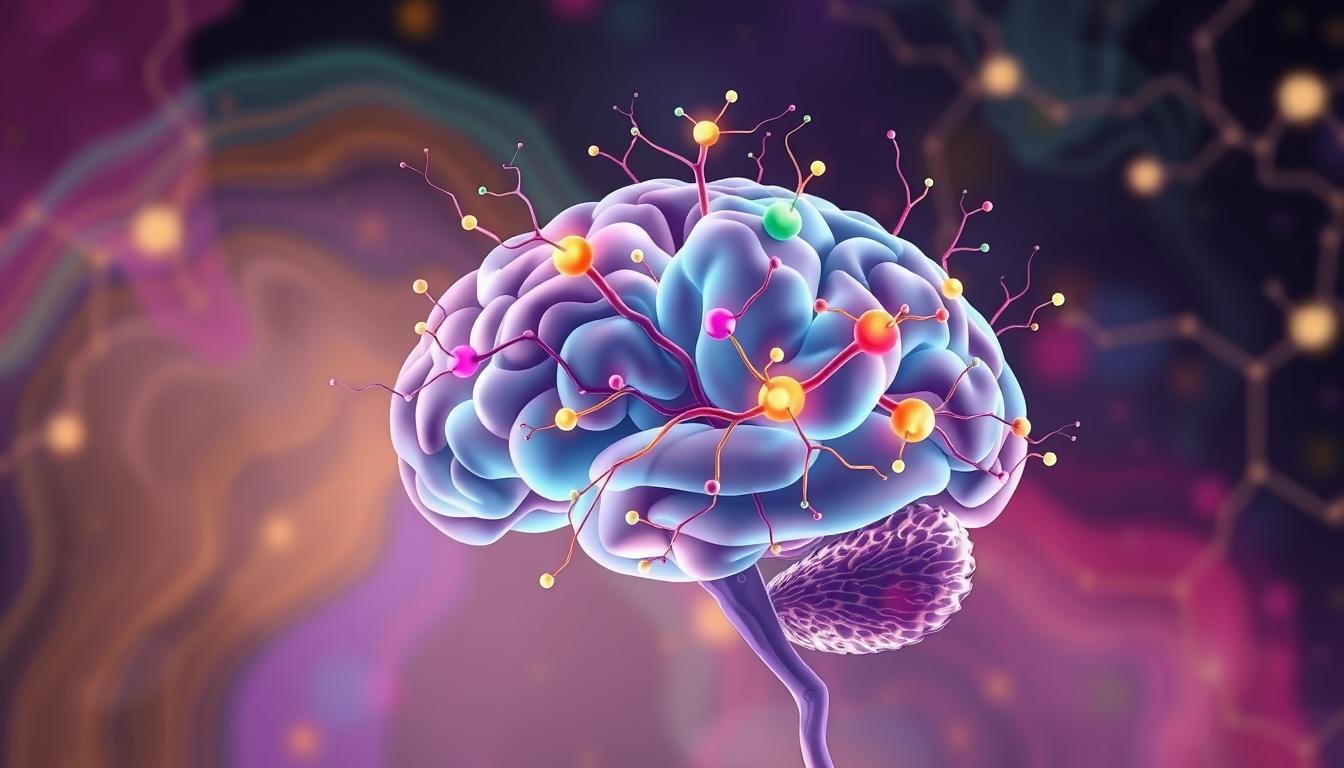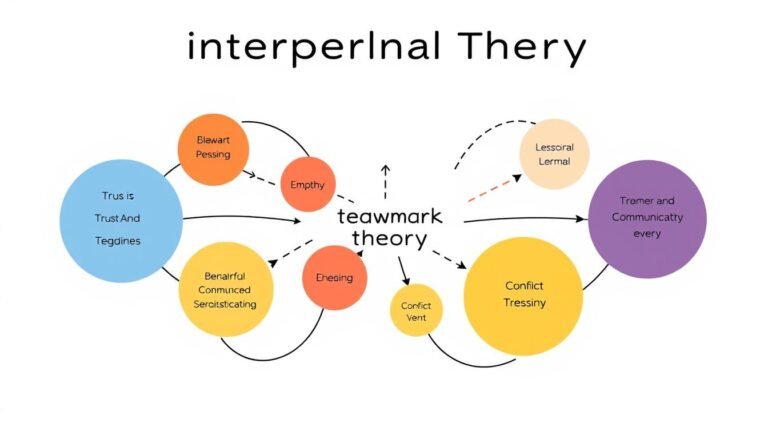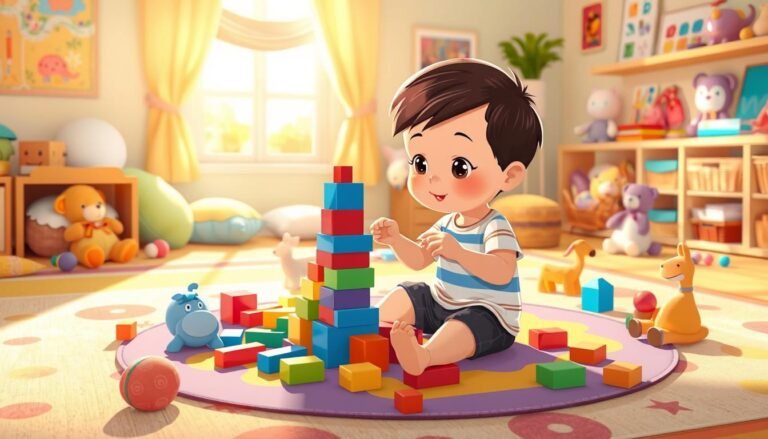Understanding Neurodevelopmental Theory
Ever wondered how a child’s mind grows from nothing to a complex mix of thoughts and feelings? This amazing journey is at the core of neurodevelopmental theory. It looks at how brain growth and thinking skills are connected.
Neurodevelopmental theory helps us see how kids learn important thinking skills. One key skill is understanding others’ thoughts and feelings, called Theory of Mind (ToM). Kids usually start to get this around 3-4 years old.
The growth of the brain is truly amazing. By 13-15 months, a child’s brain starts preparing for ToM. This is when they also start learning language fast. Early language skills are a big sign of future ToM abilities.
As we dive into neurodevelopmental theory, we’ll see how different things help a child’s thinking grow. Things like memory systems and pretend play, which kids love between 18 months and 6 years, all play a part. Each one adds to the rich picture of a growing mind.
Learning about these processes is important for real life. For example, cerebral palsy affects movement and posture in about 2 to 2.5 per 1000 births in rich countries. By understanding neurodevelopmental theory, we can tackle such challenges better.
Let’s dive into the exciting world of neurodevelopmental theory. We’ll discover how our brains grow, learn, and help us understand the world.
Introduction to Neurodevelopmental Theory
Neurodevelopmental theory is a new way to understand how children grow. It studies how the brain changes and affects a child’s skills and actions. This theory is important for learning about Theory of Mind and social cognition.
Definition and Core Concepts
Neurodevelopmental theory focuses on brain growth and its role in learning. It divides brain functions into eight main areas. These include attention, memory, language, and social skills.
The theory also looks at how we learn and think about our learning. It’s all about how our brain works.
Importance in Child Development
This theory is key to understanding child growth and learning. It explains why some kids find certain tasks hard while others do well. It helps us see how Theory of Mind develops.
This skill lets kids understand others’ thoughts and feelings. It’s crucial for making friends and getting along with others.
Historical Context and Evolution
Neurodevelopmental theory has grown a lot over time. Early ideas focused on general intelligence. Later, more detailed models came along.
These include the Cattell-Horn-Carroll model and the Structure of Intellect model. Each new idea added more to our understanding of child development.
- Charles Spearman’s general intelligence factor was an early influence
- The PASS model introduced specific cognitive processes
- Modern theories consider both genetic and environmental factors
Today, neurodevelopmental theory keeps getting better. It helps us support children’s growth, especially those facing challenges. By knowing about brain development, we can help each child reach their full potential.
The Foundations of Brain Development
Brain development starts in the womb and goes on until we’re teenagers. It shapes our thinking, social skills, and potential.
Neuroplasticity and its role
Neuroplasticity lets our brains change and adapt. In the first few years, over 1 million new neural connections form every second. This fast growth helps kids learn and adapt quickly.
Critical periods in brain development
Some stages in brain development are very important for certain skills. For example, by the first year, babies can tell sounds from their native language. The preschool years see a big increase in brain size, reaching about 90% of adult size by age 6.
Influence of genetics and environment
Genetics and environment both shape the brain. Genes give the blueprint, but environment affects how genes are used. Positive experiences and supportive relationships are key for healthy brain growth. But, chronic stress or extreme poverty can harm the brain.
“Early preventive intervention in brain development is more efficient and produces more favorable outcomes compared to later remediation.”
Knowing about brain development helps parents, educators, and policymakers. They can create better environments for kids. This sets them up for success throughout their lives.
Cognitive Functions and Neurodevelopmental Theory
Cognitive functions are key in neurodevelopmental theory. They include memory systems, attention, and executive functions. The thalamus, a vital brain part, helps with learning, memory, and making decisions in animals.
Memory systems are vital for growing cognitively. There are different types of memory, like short-term and long-term. These help kids learn and understand the world.
Executive functions, like planning and controlling impulses, are important for social skills. They help kids understand others’ thoughts and feelings. This is crucial for social interactions.
“Social cognition is foundational for human social interaction and communication.”
Studies show that executive functions grow as kids get older. They are closely tied to understanding others’ minds. This shows how different brain functions work together in kids.
| Cognitive Function | Role in Development | Related Brain Structure |
|---|---|---|
| Working Memory | Essential for Theory of Mind | Mediodorsal Thalamus |
| Executive Functions | Social Cognition, Moral Reasoning | Prefrontal Cortex |
| Attention | Information Processing, Learning | Reticular Thalamus |
Knowing about these cognitive functions and their brain links is key. It helps spot delays and plan early help. By understanding how memory, executive functions, and brain parts work together, we can support kids’ growth better.
Language Acquisition through the Lens of Neurodevelopmental Theory
Learning language is a thrilling journey for kids. Neurodevelopmental theory helps us understand how the brain grows and learns to speak. It looks at the different stages of language development, the brain’s role, and how the environment affects it.
Stages of Language Development
Children go through various stages as they learn to talk. They start with simple sounds and move to complex sentences. Each stage is linked to their brain’s growth, showing how language and brain development are connected.
- Crying and Cooing (0-3 months)
- Babbling (4-6 months)
- First Words (7-12 months)
- Word Combinations (13-24 months)
- Simple Sentences (2-3 years)
- Complex Language (4+ years)
Neural Correlates of Language Acquisition
The brain’s ability to understand and speak language is amazing. Many brain areas work together for this. Broca’s area, Wernicke’s area, and the arcuate fasciculus are crucial for language processing and production.
Impact of Environmental Factors
Environmental factors greatly affect how kids learn language. Being around lots of language, talking with others, and getting feedback from caregivers helps a lot. Research shows kids in rich language environments have bigger vocabularies and better communication skills.
| Environmental Factor | Impact on Language Acquisition |
|---|---|
| Language Exposure | Enhances vocabulary and grammar |
| Social Interactions | Improves communication skills |
| Responsive Caregiving | Supports language development |
| Reading Aloud | Boosts literacy skills |
Neurodevelopmental Theory in Practice: Early Intervention
Early intervention is key in using neurodevelopmental theory. It helps spot developmental delays early. This way, healthcare pros can start interventions that really help a child.
Identifying Developmental Delays
Spotting developmental delays is the first step. Conditions like cerebral palsy and autism spectrum disorder are common. Early detection means quicker action and better results.
Intervention Strategies and Techniques
Neurodevelopmental Treatment (NDT) is a hands-on method. It uses movements to help those with neurological issues. Studies show it greatly improves daily tasks for kids with cerebral palsy.
Role of Parents and Caregivers
Parents and caregivers are vital in helping a child grow. Research shows that working together with NDT can lead to better results. Home support adds to professional help, making a complete early intervention plan.
Source Links
- Theory of Mind and Neurodevelopmental Disorders of Childhood – Pediatric Research
- Neurodevelopmental treatment approaches for children with cerebral palsy
- Neurodevelopmental framework for learning
- InBrief: The Science of Early Childhood Development
- The Basics of Brain Development
- Frontiers | Cognitive Functions and Neurodevelopmental Disorders Involving the Prefrontal Cortex and Mediodorsal Thalamus
- What Neurodevelopmental Disorders Can Reveal about Cognitive Architecture: The Example of Theory of Mind
- Frontiers | What’s the Link Between Theory of Mind and Other Cognitive Abilities – A Co-twin Control Design of Neurodevelopmental Disorders
- Neurodevelopmental disorders: An innovative perspective via the response to intervention model
- upil400607 240..255
- Early Diagnostics and Early Intervention in Neurodevelopmental Disorders—Age-Dependent Challenges and Opportunities
- Neurodevelopmental Treatment Clinical Practice Model’s Role in the Management of Children with Cerebral Palsy








